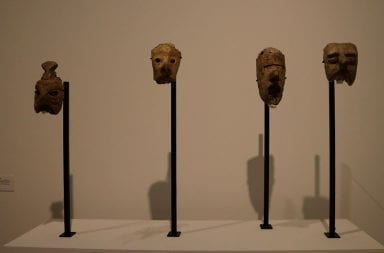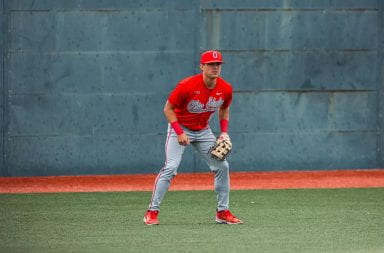On a college campus with wireless Internet in every building, where notebook computers are almost as plentiful as notebooks, Ohio State students might not think of access to technology as a pressing issue.
But there is more to the university area than state-of-the-art facilities and multi-million dollar construction projects.
“The digital divide is very real here,” Catherine Girves, director of the University Area Enrichment Association, said. The digital divide is the gap between those with access to computers and the Internet and those who do not.
The UAEA is a community group that aims to improve the quality of life in the neighborhoods surrounding campus, a 2.78 square-mile area.
The percentage of families in the university district living below the poverty line is 27.3 percent, more than three times that of the average for Franklin County, 8.2 percent, according to the Ohio State’s Center for Urban and Regional Analysis Web site.
The association opened a community computer lab in November to help bridge the digital divide.
The computer lab is tucked away under the peaked roof of the old sanctuary of Summit United Methodist Church. Stained glass still adorns some windows, reflecting blue and red hues onto the rows of 25 computers stationed there.
Girves said they are setting up a tracking system to monitor how many people use the lab, but said there are users every time the lab is open.
Students from nearby Indianola Middle School often make their way to the lab after school. Residents of the neighborhood find that it is closer to their homes than library branches, and there are fewer lines and less waiting, Girves said.
Christine Annarino, an OSU alumna who is now the volunteer coordinator for the UAEA, estimated that about 60 percent of the people who use the lab do not have consistent Internet access at home.
OSU students have also used the lab, Girves said, “either to give back to the community or because it’s convenient.”
The computers have been refurbished by Free Geek, an organization that shares space at the church with the UAEA. Free Geek receives donated computers which are rebuilt by volunteers. After volunteering for about 22 hours, participants are eligible to earn a refurbished computer, but many volunteers don’t actually take a computer and just want to volunteer, Girves said.
In the first part of 2009, according to the Free Geek Web site, 200 computers had been donated and 17 had been refurbished and given to volunteers and nonprofit organizations.
The lab computers are loaded with open-source software. While it can be unfamiliar to users at first, Girves said they use it because it is “completely accessible on a financial side.” The software itself is free and does not require costly updates every few years.
While income is a significant factor in the digital divide, Girves said, there are also barriers to access “because of the way people think about themselves and what they think they’re good at.”
“Girls and women often don’t identify as geeks,” she said.
Eva Bradshaw, the director of educational technologies for the Fisher College of Business, agreed.
“It’s not just about the dollars,” she said. “A lot of it is perception. [It’s] the sense that ‘I don’t belong. That they’re not talking about me when talking about opportunities.'”
Bradshaw heads Gidget, a “pipeline” program that encourages girls to become involved in technology from a young age.
The program works with area grade-school girls, many of whom don’t have access to computers or the Internet at home, including those at nearby Weinland Park Elementary on East Seventh Avenue.
The fourth and fifth-grade girls learn everything from word processing to how to take a computer apart in the after-school program.
Bradshaw mentioned one girl who struggled with keyboarding skills and software, but learned she liked working with her hands while taking a computer apart to learn about its hardware.
“She liked to be in there with the screwdriver takings things apart and seeing how things worked,” Bradshaw said. “Knowing that about yourself can help with career choices.”
Karen Hutzel, an assistant professor of art education at OSU, coordinated a service-learning course that focuses on girls and technology.
In the course, students work with girls from Indianola Middle School twice a week on digital photo retouching software. The OSU students and the girls meet at campus computer labs outfitted with new Mac computers for one day a week and at the community computer lab on the other.
Often the OSU students end up learning just as much from the middle school girls, Hutzel said.
The OSU students learn about “social issues related to technology and learning, and their own sense of privilege with what they have access to,” Hutzel said.
The middle school girls also show them how to be “more fearless in front of a computer.” The younger girls are more willing to grab the mouse and make mistakes, she said.
The contrast between people on either side of the digital divide may seem greater in the university area.
Annarino noted the drastic gap between people with college degrees and those who didn’t complete high school living in the same neighborhood.
But through the UAEA and other organizations, there are ways to “pull those pieces together,” Annarino said.
Bradshaw suggested that tech-savvy OSU students help their neighbors and donate their used laptops to Free Geek or groups like it.
While the area is unique, the UAEA strives to find universal solutions, Girves said.
“Can this be replicated in other neighborhoods?” she said. “Can it be done in Hilltop and Linden? Can it be done in an area without Ohio State University? Can it be done in Detroit? Can it be done in Bangkok?”


